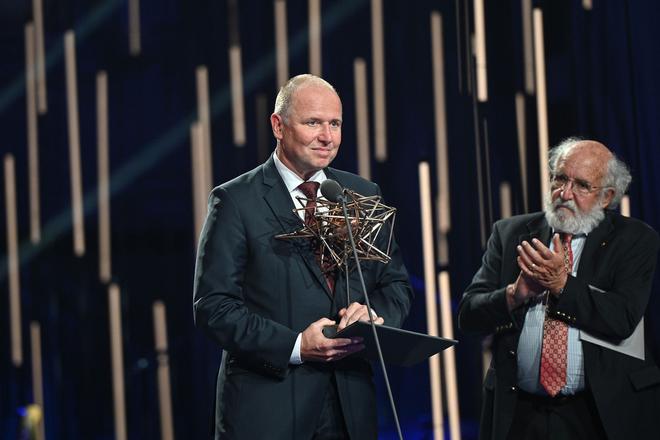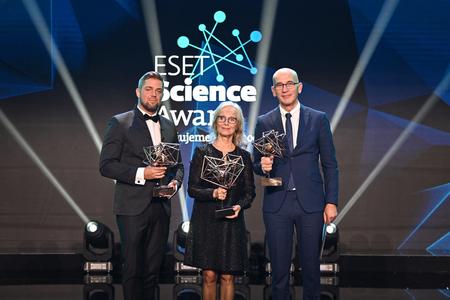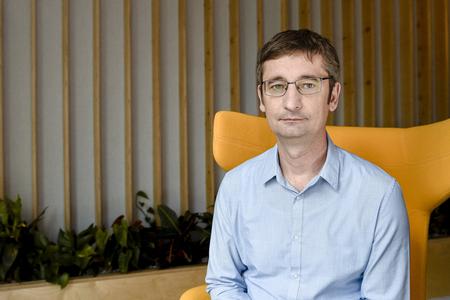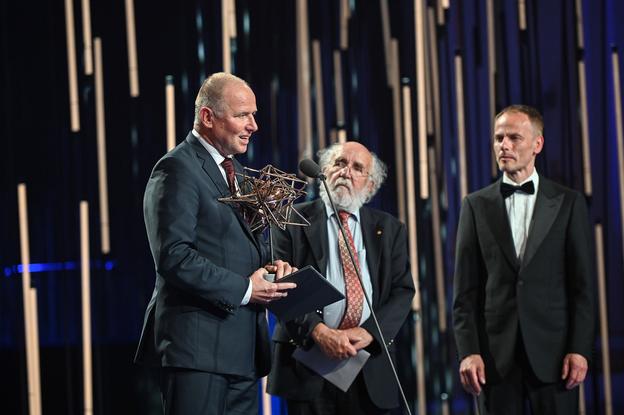It was not so long ago that large needles were used in the treatment of diabetes; later came pens, insulin pumps, and now even artificial intelligence is entering the mix.
This article is supported by the ESET Foundation, whose annual ESET Science Award recognises exceptional scientists.
Polymer chemist Igor Lacík from the Polymer Institute of the Slovak Academy of Sciences wants to further advance the treatment of diabetes and improve the lives of the many people who live with it. That’s why he is studying the use of polymer materials in the treatment of this disease. In addition, scientists under his guidance are also synthesising water-soluble polymers. Until recently, this area of research was plagued by uncertainties. Thanks to the contribution of Igor Lacík, that has changed.
This year, his work was recognised by the international jury of the ESET Science Award, headed by the Nobel laureate Michel Mayor, and Igor Lacík was announced the winner in the Outstanding Scientist in Slovakia category. The award aims to highlight the work and role of scientists in Slovakia.
The Slovak Spectator talked to Lacík about his scientific work, the use of polymers in the treatment of diabetes, cells that resemble islets, and how he got into research.
To stay up to date with what scientists in Slovakia or Slovak scientists around the world are doing, subscribe to the Slovak Science newsletter, which will be sent to readers free of charge four times a year.
A century-old idea
For the human body, the hormone insulin is absolutely necessary. It mediates the transfer of glucose – i.e. blood sugar, the main power source for cells – from blood to cells. If it is absent, or if its activity is impaired, diabetes occurs. The discovery of the hormone and its subsequent production has saved of millions of lives around the world since the 1920s.
Treatment of diabetes is constantly evolving and is widely provided in Slovakia. However, in a small but still significant group of patients, current treatment is not able to control sugar levels. These patients typically have hyperglycaemia, i.e. a high blood sugar level, or hypoglycaemia, i.e. a low blood sugar level. In the case of the latter, patients usually experience clinical symptoms, such as tremors, sweating, etc. They can even experience severe sugar cravings.
"My [diabetic] friend dreams that he is eating Horalka [a traditional sweet wafer snack - Ed. note]," Lacík says.
In addition, there is a group of people with uncontrolled hypoglycaemia who do not experience such symptoms that tell them they need sugar. They may have to wake up at night several times to check their sugar level, for fear of slipping into a coma, are hence in constant stress. In their case, the pumps that deliver precise doses of insulin do not work. There are also patients whose pancreas, the organ that produces insulin, needs to be removed for health reasons. They then become diabetics. Last but not least, there are also patients who end up needing kidney transplants, because this is one of the first organs to fail as a result of diabetes.
For these three groups, cell therapy in the form of pancreatic islet transplantation is one way to go. These are clusters of cells that make up roughly two percent of the pancreas’ volume. The clusters contain several types of cells, but for the purposes of the treatment, two are important: alpha cells that produce glucagon, a hormone that increases sugar levels, and beta cells, which produce insulin.
When insulin was first discovered, more than a hundred years ago, the islet transplantation was considered – but the success rate was low and it was considered a failure. Now, 60 percent of patients with transplanted islets function like healthy people.
"In terms of sugar control, transplanted islets effectively act as your own pancreas," Lacík explains.
Functional islets are isolated from the pancreas. If the organ has to be removed from the patient, then the islets can be isolated from it; otherwise they are taken from the pancreas of a deceased donor. In the case of the latter, there is a selection process, but it is not as strict as with organs, so there are potentially more donors. Still, immunosuppressants are subsequently necessary, since the islets represent tissue from a different body, that is connected with the rejection of islets.
The road to curing diabetes
When the co-discoverer of insulin, Frederick Banting, received the Nobel Prize in 1923, he said that insulin was only a treatment, not a cure:
"Currently, it is said that if the islets can be transplanted in such a way that immunosuppressants would not be necessary, then we would have a functional cure. So yes, we would cure diabetes. The immune system would not intervene; a patient would be able to have their sugar level controlled without drugs. That would be a big milestone."
Transplantation is a one-day outpatient procedure. Isolated islets are injected into the liver through the organ’s entrance vein. They then disperse into the bloodstream, where they react to sugar levels and release hormones accordingly.
If a patient is to avoid immunosuppressants, the transplanted islets must be isolated from the immune system. This is where Igor Lacík's polymer research comes into play.
"We wrap them in a semi-permeable polymer membrane, one that would allow the penetration of glucose without restriction and at the same time permit the secretion of hormones. Moreover, in order for the islets to survive for a long time, i.e. for at least months and years, nutrients, oxygen and must also get to them and metabolites need to be released. At the same time, the immune system must not get in, otherwise it would destroy them," Lacík explains as he describes his research. If the islets stop working after a certain time, they can be transplanted again.
"We have to find a polymer that fulfils all of these attributes. It also needs to be biocompatible, which means the body will not recognize it and will not, therefore, want to get rid of it. We want it to become friends with the islets, not to be toxic to them. We have to ensure that the polymer membrane is also stable during the functioning of the islets."
Lacík's team uses hydrogel spheres with a diameter of up to one millimetre for transplantation. These are either various polysaccharides, or a combination of polysaccharides and synthetic polymers, which in mouse models meet all the attributes set out by Lacík. However, some experiments in primates were successful, while others were not. As a result, the tests have currently been suspended and his team is adjusting the properties of the polymers.
"At the moment, the whole world is trying to improve this polymer so that we have a material that works for a long time," he says.
At what stage is the research?
Although the principle is simple, according to Lacík, we are still not at the stage where a doctor can recommend a finished product to their patients. Scientists still do not fully understand the details of how, when and why the islets survive, how to properly set biocompatibility, and so on.
"It's definitely a safe procedure, but now we're working to make it a functional procedure as well," he says.
At the institute, they are currently working on improving the material.
Preclinical tests on primates have shown that the microcapsules suffer when it comes to stability and biocompatibility. While not a problem in mice, a strong immune reaction was observed on explanted microcapsules in primates.
"There is debate about which model is appropriate, in order to determine if these materials are suitable for human testing. In the US and in the consortia where we have been involved, primate models are required, but there are others who say mouse models might be enough, because even a primate model is not a guarantee of a suitable comparison," Lacík explains.
"We discovered that in primates we need more stable and biocompatible materials, so we are going in this direction. This is also being researched elsewhere in the world," he adds.
Availability in Slovakia
For the three groups of patients mentioned by Lacík, the transplantation of islets was not available in the country for a very long time.
It took until November of last year for a patient to have their pancreatic islets transplanted. The patient had pancreatitis, and his organ was removed in Martin, northern Slovakia. It was then transported to Prague, where the islets from it were isolated at the Institute for Clinical and Experimental Medicine (IKEM). These islets were then transported back to Martin for subsequent transplantation. The patient does not need to take immunosuppressants because the original tissue was his own.
Another transplant took place in September this year in Košice, eastern Slovakia, but this time the islets were from another donor.
"Patients know about the therapy, and although it is available, it has not yet been established as a systemic therapy. It is something that Slovakia needs to have. Whether it will take place through IKEM or there will be a hospital with this capability, remains to be seen. Steps in this direction have been made, and we are applying for a project," he says.
Research that is cited worldwide
In addition to diabetes research, Igor Lacík's scientific team is also dedicated to the synthesis of water-soluble polymers. These can be used to create hydrogels, purify water, extract water from underground, and are used in toothpastes, shampoos and pills.
Such polymers have been known for a very long time and are produced in huge quantities, but despite this, the basis of their synthesis was not known. The description of polymerisation that applied to common types of polymers could not be applied to water-soluble polymers. And so explanations were sometimes used that were not always true.
"I initiated this topic and subsequently, in cooperation with important workplaces around the world, after 20 years we provided a detailed description of these complicated polymerisation systems."
The polymer chemist arrived at this area of research thanks to long-term stays abroad. At first, he started with the synthesis of polymers, and as a PhD student he joined the then best group in Australia. After defending his thesis, he went to France, where he worked with another top scientist on water-soluble polymers. Then he was invited to the US, where he worked on their application in diabetes treatment.
"When I returned to Slovakia, nothing was being done in this area at that time, so I tried to combine these two topics. I proposed a cooperation with the German company BASF," he says. The year was 1999 and the research conditions in Slovakia had been created for Lacík to do his work. Then came cooperation with other companies.
"It was an incredible step forward. We explained and described the processes. Now universities and companies are citing us and using the results we obtained."
This article is supported by the ESET Foundation, whose annual ESET Science Award recognises exceptional scientists.






